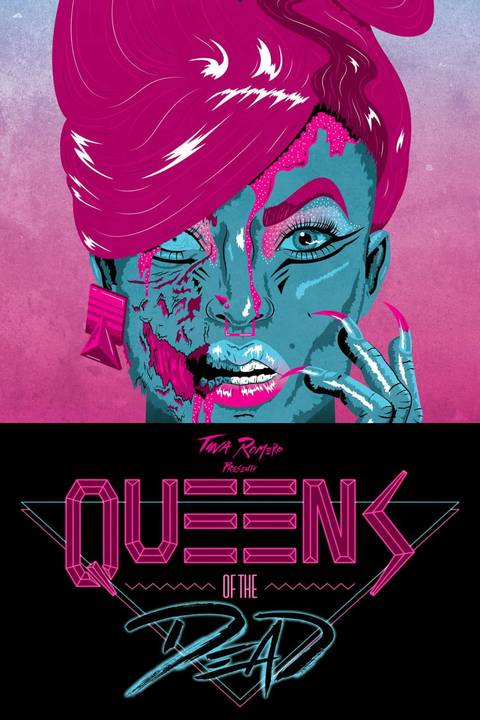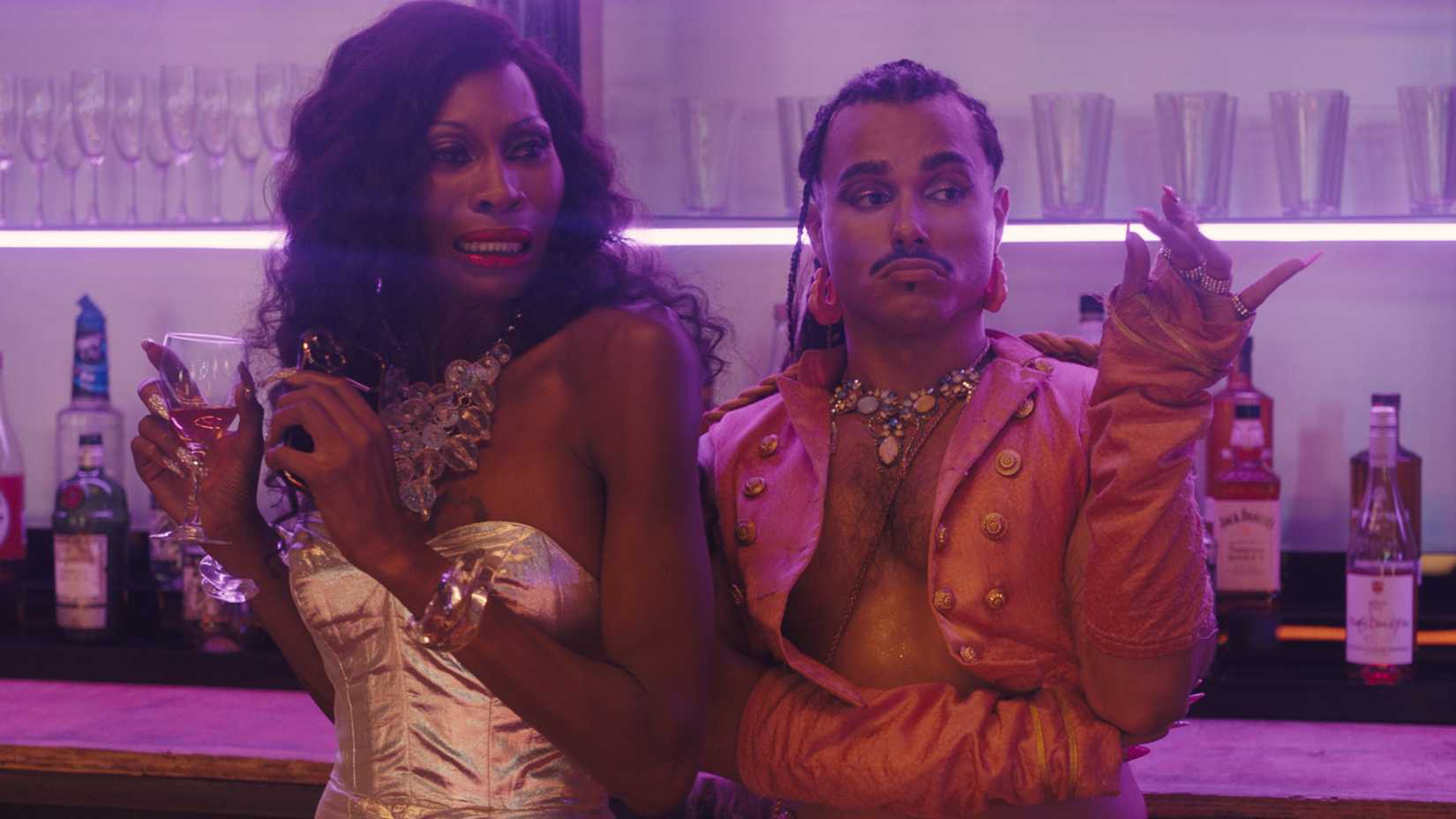If memory serves, George A. Romero’s Night of the Living Dead didn’t have lines even remotely in the realm of “gym rats and twinks only” or “I’m captain of the Gen Z float for Pride.” In fact, it’s unclear if any of those words existed at the time. But in 2025, Romero’s daughter is accepting the zombie cinema torch with a very specific taste for queer resilience, the beauty and grit of New York City nightlife and glitter blood. Writer-director Tina Romero’s debut feature Queens of the Dead puts a Brooklyn drag-queen spin on the zombie subgenre, with zombies decked out in rhinestones and serving looks that slay the house down boots — literally.

- Release Date
-
October 24, 2025
- Runtime
-
99 minutes
- Director
-
Tina Romero
- Writers
-
Tina Romero, Erin Judge
- Producers
-
Matt Miller
Drag emcee and mother figure Ginsey (Nina West) declares that “drag is not life or death, it’s fun.” But in Queens of the Dead, everyone’s life is on the line. Co-written by Erin Judge, Queens of the Dead sees a Saturday night in Bushwick go awry; not only is this warehouse party plagued with unreliable diva drag queens, exhausting drama and a broken toilet, but metallic green zombies have suddenly swarmed the city, and no one is safe. The film is brimming with niche queer icons who bring a warm, affectionate vibe of authentic representation to the film, like Katy O’Brian (Love Lies Bleeding), Jaquel Spivey (Mean Girls, 2024), Jack Haven (I Saw the TV Glow), Margaret Cho (Drop Dead Diva, Fire Island), Tomas Matos (Fire Island), Nina West (RuPaul’s Drag Race), Dominique Jackson (Pose) and Cheyenne Jackson (American Horror Story).
The horror genre offers an extensive catalog of films that speak on sociopolitical issues and spotlight marginalized communities, metaphorically or otherwise. The late George Romero’s films are political in nature, touching on America’s racial tensions, Vietnam-era nihilism, capitalism and consumer culture — often with a touch of satire. His daughter’s low-budget genre-bending zombie flick is no different: It’s an unapologetically queer film that touches on the trans and gender-expansive experience during a time of political turmoil, divide and isolation in the U.S. She gets it from her dad, and she knows it. Even so, the film’s fictional mayor of NYC uttering the line, “this is not a George Romero movie,” sends a clear message.
The film opens with bedazzled platform heels strutting on a Brooklyn sidewalk, as the drag queen (played by NYC nightlife star Julie J) in question tells a pal over the phone that she’s on her way to church to donate a few bucks for her nana. While she’s in said place of worship, however, it isn’t long before she matches with a man on a Grindr-like dating app who goes by “Choir Daddy.” Her hunt for Choir Daddy will be her final hunt for trade, as a slow-moving zombie emerges from the shadows and chomps at the queen.
Meanwhile, party promoter Dre (Katy O’Brian) is anxiously juggling tasks hours before her upcoming party. The DJ is M.I.A., the toilet is still out of order and her headliner, the grandiose Yasmine (Dominique Jackson), is about to flake for a glitzy vodka campaign event. Dre’s wife, a nurse named Lizzy (Riki Lindhome), ever-so kindly calls her brother, Barry (Quincy Dunn-Baker), — a not-so woke and stereotypically macho New York guy who listens to questionable podcasts — to come fix the warehouse toilet. While all this is happening, Lizzy is on a shift with fellow hospital worker Sam (Jaquel Spivey); as it turns out, Sam was once a big deal at Dre’s parties, performing as an illustrious larger-than-life drag queen before a wave of low self-confidence and an identity crisis led them to flake on Dre when she needed them most. Now, they’re handing out Jell-O cups to patients while dreaming of the stage.
As the zombie apocalypse commences, infected drag queens and club kids begin roaming the streets, scrolling through their phones in an absent-minded haze while searching for brains. Not only are their lives in danger, but the eccentric cast of characters must learn to put aside their differences, rivalries and long-standing grudges to make it through the night.
Queens of the Dead is delightfully flamboyant in its absurdity and adoration for the plucky, glamorous chaos of the nightlife scene — a particularly hilarious rendition of Kesha’s “Blow” speaks to the film’s intentional and very consistent buffoonery. Considering its ghouls are shimmery, sluggish (they’re in six-inch platform heels, mind you) and very brain-dead, the true horror of Queens of the Dead is in its political commentary, which reminds us that America, not to mention the LGBTQ+ community, is at odds with itself. Still, these nudges are made with a wink, and maybe even a “period!” from the ever-charming Tomas Matos, as Romero keeps the mood light and the vibe fabulous.
If anything, Queens of the Dead is more aligned with RuPaul’s Drag Race, The Boulet Brothers’ Dragula, or the work of John Waters than a George Romero film — or any “traditional” zombie film, for that matter. Tina Romero opts for a “glam gore” aesthetic inspired by the maximalist art of Marilyn Minter, while still paying homage to the gray-green ghouls of her father’s Dawn of the Dead.
This is certainly a “what you see is what you get” movie, cheese and all, which means that it may not work for guys who wear T-shirts that say, “written and directed by Quentin Tarantino.” No shade, though, as Tina Romero insists her film “has an open-arms policy: everyone is welcome here.” Everyone is welcome, and everyone is (playfully) a target: The script softly pokes fun at the ignorance of right-leaning Joe Rogan talking heads, as well as the hypocritical attitudes that weigh down the queer community’s proclamations of acceptance. In the end, Queens of the Dead is a film that embraces empathy, pride and the ludicrous fun of a death-by-disco-ball kill scene. Period.
From IFC and Shudder, Queens of the Dead drags its undead legs to theaters on October 24, 2025.



